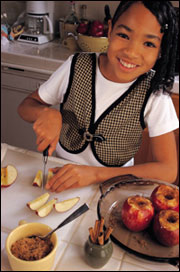Be Food Safe
 Most people do not think about food safety until they or someone they know becomes infected with foodborne illness. People usually become infected with foodborne illness when they eat a contaminated food item.
Most people do not think about food safety until they or someone they know becomes infected with foodborne illness. People usually become infected with foodborne illness when they eat a contaminated food item.
September is National Food Safety Education Month®.

It's National Food Safety Month®
An estimated 76 million cases of foodborne disease occur each year in the United States. CDC estimates that there are 325,000 hospitalizations and 5,000 deaths related to foodborne diseases each year. With the recent high-profile Salmonella Saintpaul outbreak fresh on our minds, now is an ideal time for food safety education.
Common Foodborne Illnesses and Symptoms
The most common foodborne illnesses are caused by the bacteria Campylobacter, Salmonella, and E. coli O157:H7, and by a group of viruses called calicivirus, also known as the Norwalk and Norwalk-like viruses. Symptoms vary depending on the type of bacteria and severity of the illness. Common symptoms include nausea, vomiting, abdominal cramps and diarrhea. See your doctor or healthcare provider when diarrheal illness is accompanied by a high fever (temperature over 101.5°F, measured orally), blood in the stools, prolonged vomiting that prevents keeping liquids down, signs of dehydration, including a decrease in urination, a dry mouth and throat, and feeling dizzy when standing up or if diarrheal illness lasts more than 3 days
Reducing Your Risk
You can reduce your risk of becoming infected with foodborne illness. Do not eat raw or undercooked meat, including hamburgers, poultry, and seafood, and do not drink raw milk or eat products made from raw milk. Rinse fresh fruits and vegetables under running water and always follow the rules of food safety.
Rules of Food Safety
Safe Internal Temperatures
Hamburgers — 160°F
Roasts, steaks, chops — 160°F
Ground poultry — 165°F
Poultry parts — 170°F
Pork — 160°F
Hot dogs/leftovers — 165°F
- CLEAN
Clean your hands with soap and warm water before handling food. Clean surfaces before preparing food on them. - SEPARATE
Separate cooked foods from ready-to-eat foods. Do not use utensils on cooked foods that were previously used on raw foods and do not place cooked foods on plates where raw foods once were unless it has been cleaned thoroughly. - COOK
Cook foods to a safe internal temperature (see chart). Use a meat thermometer to make sure foods are cooked to a safe temperature. Color is not an indicator of doneness. - CHILL
Chill foods promptly after serving and when transporting from one place to another. Keep your refrigerator at 40°F or below. Keep hot foods hot and cold foods cold.
More Information
For more information about foodborne illness and food safety, call 1-800-CDC-INFO, e-mail cdcinfo@cdc.gov, or visit these Web sites:

